жӮЁеҘҪпјҢзҷ»еҪ•еҗҺжүҚиғҪдёӢи®ўеҚ•е“ҰпјҒ
жӮЁеҘҪпјҢзҷ»еҪ•еҗҺжүҚиғҪдёӢи®ўеҚ•е“ҰпјҒ
иҝҷзҜҮж–Үз« е°ҶдёәеӨ§е®¶иҜҰз»Ҷи®Іи§Јжңүе…іPython3.5йқўеҗ‘еҜ№иұЎдёҺ继жүҝзҡ„зӨәдҫӢеҲҶжһҗпјҢе°Ҹзј–и§үеҫ—жҢәе®һз”Ёзҡ„пјҢеӣ жӯӨеҲҶдә«з»ҷеӨ§е®¶еҒҡдёӘеҸӮиҖғпјҢеёҢжңӣеӨ§е®¶йҳ…иҜ»е®ҢиҝҷзҜҮж–Үз« еҗҺеҸҜд»ҘжңүжүҖ收иҺ·гҖӮ
е…·дҪ“еҰӮдёӢпјҡ
1гҖҒзј–зЁӢзҡ„ж–№ејҸ
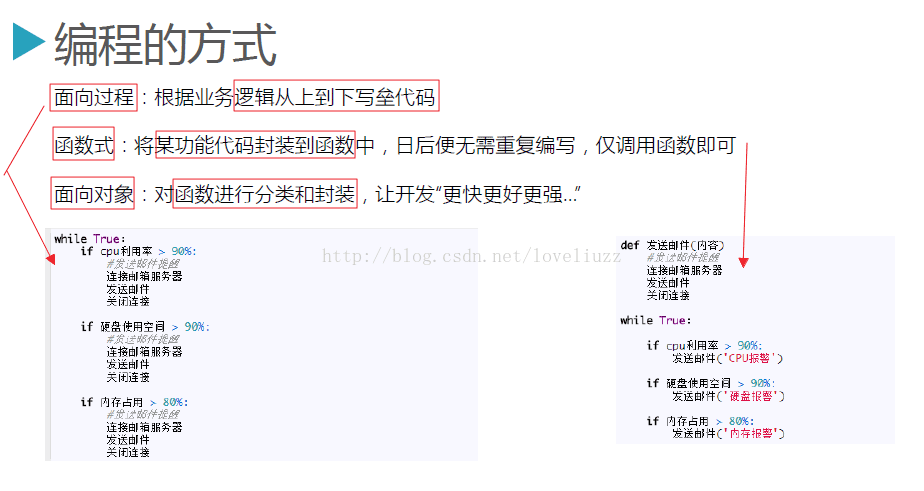
2гҖҒйқўеҗ‘еҜ№иұЎзҡ„еҹәжң¬жҰӮеҝө
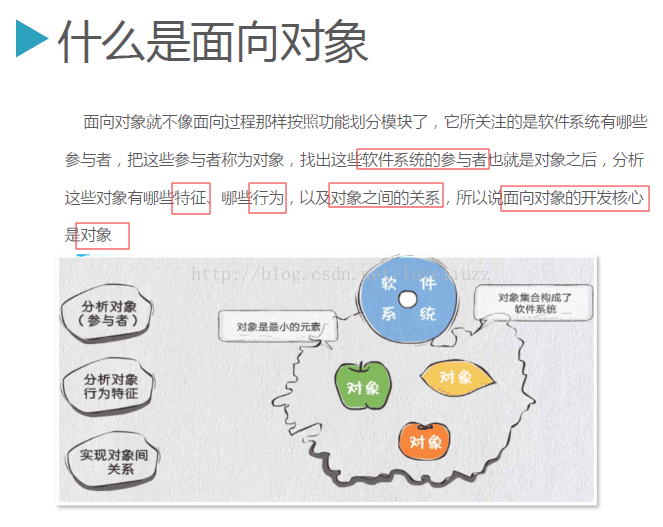


3гҖҒзұ»зҡ„еҹәжң¬жҰӮеҝө
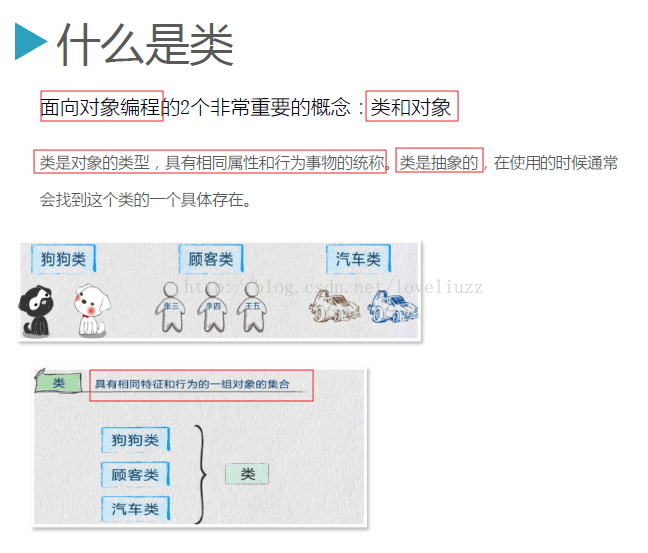


4гҖҒзұ»зҡ„е®ҡд№үдёҺи°ғз”ЁвҖ”вҖ”з®ҖеҚ•д»Јз ҒдёҫдҫӢ
жіЁпјҡе»әи®®зұ»еҗҚзҡ„ејҖеӨҙеӯ—жҜҚз”ЁеӨ§еҶҷпјҢеңЁPythonдёӯпјҢзұ»еҶ…зҡ„еҮҪж•°з§°дҪңж–№жі•пјҢзұ»еӨ–зҡ„еҮҪж•°иҝҳжҳҜз§°дҪңеҮҪж•°гҖӮ

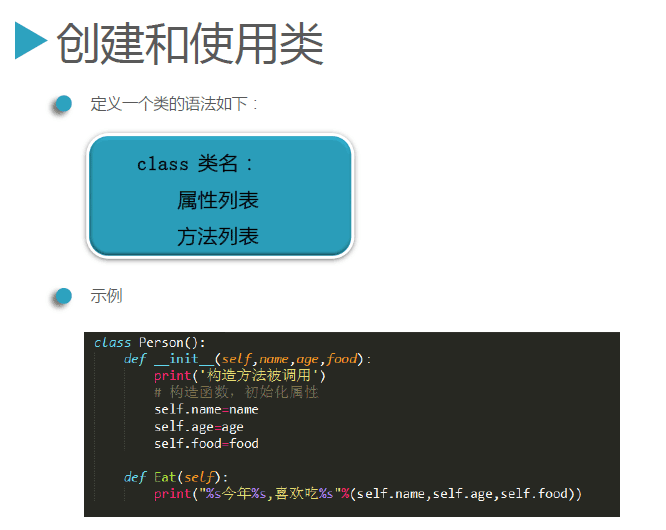


#!/usr/bin/env python
# -*- coding:utf-8 -*-
# Author:ZhengzhengLiu
#зұ»
class Person:
i = 10 #еұһжҖ§пјҲеҸҳйҮҸпјү
def eat(self): #ж–№жі•пјҲеҮҪж•°пјү
print("eating...")
pass
#зұ»зҡ„и°ғз”Ё
a = Person()
a.eat()иҝҗиЎҢз»“жһңпјҡ
eating...
class Person():
#еҜ№иұЎеұһжҖ§ жһ„йҖ ж–№жі• еңЁе®һдҫӢеҢ–еҜ№иұЎж—¶дјҡиҮӘеҠЁи°ғз”Ё
# е®һдҫӢеҢ–зҡ„еҜ№иұЎе°ұе…·жңүnameе’ҢageдёӨдёӘеұһжҖ§
#selfжҳҜжҢҮеҪ“еүҚзҡ„еҜ№иұЎ selfдёҚжҳҜе…ій”®еӯ—еҸҜд»Ҙиў«д»ЈжӣҝпјҢдҪҶжҳҜд№ жғҜдҪҝз”ЁselfжҢҮд»ЈеҪ“еүҚеҜ№иұЎ
def __init__(self,name,age):
# йҖҡиҝҮжһ„йҖ ж–№жі•еЈ°жҳҺдәҶдёӨдёӘеҜ№иұЎеұһжҖ§
#еҜ№иұЎ.nameеұһжҖ§ = nameеҸӮж•°
self.name = name
self.age = age
#еЈ°жҳҺдёҖдёӘзұ»ж–№жі•
def speak(self):
print("Hello,my name is %s,and I'm %d years old" %(self.name,self.age))
#еҲӣе»әе®һдҫӢеҜ№иұЎ дјҡи§ҰеҸ‘жһ„йҖ ж–№жі•
people01 = Person("Jack",18) #йҖҡиҝҮPersonзұ»е®һдҫӢеҢ–еҮәдёҖдёӘpeopleеҜ№иұЎ
print(people01) #жү“еҚ°PersonеҜ№иұЎеңЁеҶ…еӯҳдёӯзҡ„ең°еқҖ
print(people01.name,people01.age) #жү“еҚ°еҜ№иұЎзҡ„еұһжҖ§
#з»ҷеҜ№иұЎж·»еҠ еұһжҖ§
people01.sex = "F"
print(people01.sex)
#зұ»ж–№жі•зҡ„и°ғз”Ё
people01.speak()иҝҗиЎҢз»“жһңпјҡ
<__main__.Person object at 0x0059C5B0>
Jack 18
F
Hello,my name is Jack,and I'm 18 years old
5гҖҒзұ»зҡ„ж–№жі•


зӨәдҫӢд»Јз Ғпјҡ
#ж–№жі•вҖ”вҖ”йқҷжҖҒж–№жі•
class S():
#е®һдҫӢпјҲеҜ№иұЎпјүеұһжҖ§
def __init__(self,name,age): #selfдёҖиҲ¬жҢҮе®һдҫӢеҜ№иұЎ
self.name = name
self.age = age
@staticmethod #з”ЁstaticmethodиЈ…йҘ°еҷЁдҝ®йҘ° иЎЁзӨәtest2дёәйқҷжҖҒж–№жі•
def test2(): #дёҚиғҪдј е…Ҙself еҜ№иұЎзҡ„еј•з”Ё
print("test2...")
s1 = S("Joe",18)
s1.test2() #йҖҡиҝҮе®һдҫӢи°ғз”ЁйқҷжҖҒж–№жі•
S.test2() #йҖҡиҝҮзұ»еҗҚи°ғз”ЁйқҷжҖҒж–№жі•
#ж–№жі•вҖ”вҖ”зұ»ж–№жі•
class C():
#зұ»еұһжҖ§
country = "China"
#е®һдҫӢпјҲеҜ№иұЎпјүеұһжҖ§
def __init__(self,name,age):
self.name = name
self.age = age
@classmethod #з”ЁclassmethodиЈ…йҘ°еҷЁдҝ®йҘ° иЎЁзӨәtest3дёәзұ»ж–№жі•
def test3(cls): #clsжҢҮзҡ„жҳҜзұ»
print("test3...",cls.country) #зұ»ж–№жі•и°ғз”Ёзұ»еұһжҖ§
c1 = C("Jack",18)
c1.test3() #йҖҡиҝҮе®һдҫӢи°ғз”Ёзұ»ж–№жі•
C.test3() #йҖҡиҝҮзұ»еҗҚи°ғз”Ёзұ»ж–№жі•иҝҗиЎҢз»“жһңпјҡ
test1...
test2...
test2...
test3... China
test3... China

пјҲ1пјүжһ„йҖ ж–№жі•пјҡжһ„йҖ ж–№жі•дёҚиғҪйҮҚиҪҪпјҲиў«иҰҶзӣ–пјү
еңЁPythonдёӯеҶ…зҪ®пјҢжҜҸдёҖдёӘзұ»йғҪжңүдёҖдёӘй»ҳи®Өзҡ„дёҚеёҰеҸӮж•°зҡ„жһ„йҖ ж–№жі•пјҢдёҚйңҖиҰҒдәәдёәзҡ„еҚ•зӢ¬и°ғз”ЁпјҢеңЁи°ғз”Ёзұ»зҡ„еҗҢж—¶е°ұиҝҗиЎҢдәҶжһ„йҖ ж–№жі•гҖӮ
жһ„йҖ ж–№жі•зҡ„дҪңз”ЁпјҡеҲқе§ӢеҢ–ж•°жҚ®гҖҒеҲӣе»әеҜ№иұЎпјҲжһ„йҖ ж–№жі•зҡ„и°ғз”Ёпјү

#!/usr/bin/env python
# -*- coding:utf-8 -*-
# Author:ZhengzhengLiu
class Person:
def __init__(self):
print("жһ„йҖ ж–№жі•")
pass
Person() #зұ»зҡ„и°ғз”Ё--еҲӣе»әеҜ№иұЎиҝҗиЎҢз»“жһң
жһ„йҖ ж–№жі•
еёҰеҸӮж•°зҡ„жһ„йҖ ж–№жі•пјҡ
#!/usr/bin/env python
# -*- coding:utf-8 -*-
# Author:ZhengzhengLiu
class Person:
# def __init__(self):
# print("жһ„йҖ ж–№жі•")
def __init__(self,x):
print("еёҰеҸӮж•°зҡ„жһ„йҖ ж–№жі•:",x)
def add(self,x,y):
print(x+y)
pass
zs = Person("hello") #зұ»зҡ„и°ғз”Ё--еҲӣе»әеҜ№иұЎ
zs.add(1,2) иҝҗиЎҢз»“жһңпјҡ
еёҰеҸӮж•°зҡ„жһ„йҖ ж–№жі•: hello
3
пјҲ2пјүйқўеҗ‘еҜ№иұЎзҡ„жҖқи·Ҝ

пјҲ3пјүзұ»ж–№жі•
#!/usr/bin/env python
# -*- coding:utf-8 -*-
# Author:ZhengzhengLiu
#зұ»ж–№жі•
class Person:
def eat(self): #зұ»ж–№жі•
print("eating...")
pass
a = Person() #зұ»ж–№жі•и°ғз”Ё
a.eat()иҝҗиЎҢз»“жһңпјҡ
eating...
пјҲ4пјүз§Ғжңүж–№жі•
еҸӘе…Ғи®ёеңЁзұ»зҡ„еҶ…йғЁдҪҝз”ЁпјҢдё“й—Ёдёәзұ»жңҚеҠЎзҡ„гҖӮ
#!/usr/bin/env python
# -*- coding:utf-8 -*-
# Author:ZhengzhengLiu
class Person:
def eat(self): # зұ»ж–№жі•
print("eating...")
self.__sleep() # и°ғз”Ёз§Ғжңүж–№жі•
def __sleep(self): #з§Ғжңүж–№жі•--зұ»зҡ„еӨ–йғЁдёҚиғҪдҪҝз”Ё
print("sleeping...")
pass
b = Person()
b.eat()иҝҗиЎҢз»“жһңпјҡ
eating...
sleeping...
6гҖҒеұһжҖ§



зӨәдҫӢеұһжҖ§гҖҒзұ»еұһжҖ§д»Јз Ғпјҡ
#!/usr/bin/env python
# -*- coding:utf-8 -*-
# Author:ZhengzhengLiu
#еұһжҖ§
class a():
def __init__(self,name,age):
self.name = name #е®һдҫӢеұһжҖ§
self.age = age
#зұ»еҶ…йғЁдҪҝз”Ёе®һдҫӢеұһжҖ§ self.е®һдҫӢеұһжҖ§еҗҚ
def get(self):
print(self.name)
a1 = a("Jack",18)
#зұ»еҶ…йғЁдҪҝз”Ёе®һдҫӢеұһжҖ§ self.е®һдҫӢеұһжҖ§еҗҚ
a1.get()
#зұ»еӨ–йғЁдҪҝз”Ёе®һдҫӢеұһжҖ§ еҜ№иұЎеҗҚ.е®һдҫӢеұһжҖ§еҗҚ
print(a1.name)
#зұ»еұһжҖ§ еңЁ__init__()ж–№жі•еӨ–еЈ°жҳҺ
#зұ»еҶ…йғЁдҪҝз”Ё зұ»еҗҚ.еұһжҖ§еҗҚ и°ғз”Ё
#зұ»еӨ–йғЁдҪҝз”ЁйҖҡиҝҮ зұ»еҗҚ.еұһжҖ§еҗҚ жҲ–иҖ… еҜ№иұЎеҗҚ.еұһжҖ§еҗҚ ж–№ејҸи°ғз”Ё
class b():
name = "Janne" #зұ»еұһжҖ§
#зұ»еҶ…йғЁдҪҝз”Ёзұ»еұһжҖ§вҖ”вҖ”зұ»еҗҚ.еұһжҖ§еҗҚ
def get(self):
print(b.name)
#зұ»еӨ–йғЁдҪҝз”Ёзұ»еұһжҖ§ йҖҡиҝҮ зұ»еҗҚ.еұһжҖ§еҗҚ
print(b.name)
#зұ»еӨ–йғЁдҪҝз”Ёзұ»еұһжҖ§ йҖҡиҝҮ еҜ№иұЎеҗҚ.еұһжҖ§еҗҚ
b1 = b()
print(b1.name)
#зұ»еҶ…йғЁдҪҝз”Ёзұ»еұһжҖ§вҖ”вҖ”зұ»еҗҚ.еұһжҖ§еҗҚ
b1.get()иҝҗиЎҢз»“жһңпјҡ
Jack
Jack
Janne
Janne
Janne
пјҲ1пјүзұ»еұһжҖ§/зұ»еҸҳйҮҸпјҡеңЁзұ»зҡ„еӨ–йғЁеҸҜд»Ҙи°ғз”Ё
пјҲ2пјүз§ҒжңүеҸҳйҮҸ/з§ҒжңүеұһжҖ§пјҡеҸӘиғҪеңЁзұ»зҡ„еҶ…йғЁпјҢйҖҡиҝҮselfдҪҝз”Ё
#!/usr/bin/env python
# -*- coding:utf-8 -*-
# Author:ZhengzhengLiu
#еұһжҖ§/еҸҳйҮҸ
class Person:
i = 10 #зұ»еұһжҖ§/зұ»еҸҳйҮҸ
__j = 20 #з§ҒжңүеұһжҖ§/з§ҒжңүеҸҳйҮҸ
def eat(self): # зұ»ж–№жі•
print("eating...")
print(self.__j) # и°ғз”Ёз§ҒжңүеҸҳйҮҸ
pass
b = Person()
print(b.i) #йҖҡиҝҮеј•з”Ёи°ғз”ЁпјҲе»әи®®пјү
print(Person.i) #еҸҜйҖҡиҝҮзұ»еҗҚи°ғз”Ё
b.eat()иҝҗиЎҢз»“жһңпјҡ
10
10
eating...
20

class GirlFriend():
#еЈ°жҳҺеҜ№иұЎеұһжҖ§ йҖҡиҝҮжһ„йҖ ж–№жі•
def __init__(self,name,age,phone,pwd):
#з»ҷеҜ№иұЎзҡ„еұһжҖ§пјҲеҸҳйҮҸеҗҚпјүеүҚйқўеҠ дёҠ __ жҲҗдёәдәҶз§Ғжңүзҡ„еұһжҖ§
self.__name = name
self.__age = age
self.__phone = phone
self.__pwd = pwd
#йҖҡиҝҮйў„з•ҷзҡ„жҺҘеҸЈ еҜ№з§ҒжңүеұһжҖ§еҗҚиҝӣиЎҢи®ҝй—®жҲ–дҝ®ж”№
def getInfo(self,pwd):
if pwd == "1234":
print("My girlfriend is %s,and she's %d years old,Her telephone number is %d"%(self.__name,self.__age,self.__phone))
else:
print("you failed...")
def setName(self,name):
self.__name = name #зұ»еҶ…дҝ®ж”№з§ҒжңүеұһжҖ§
gf = GirlFriend("Janne",18,13511112222,"1234")
gf.setName("Malianna")
gf.getInfo("1234")иҝҗиЎҢз»“жһңпјҡ
My girlfriend is Malianna,and she's 18 years old,Her telephone number is 13511112222

пјҲ3пјүзү№ж®Ҡзҡ„зұ»еұһжҖ§

7гҖҒ继жүҝ
Pythonдёӯж”ҜжҢҒеӨҡ继жүҝпјҢдҪңз”ЁпјҡеӨҚз”ЁпјҢдёҚе»әи®®дҪҝз”ЁеӨҡ继жүҝпјҲзұ»еҜ№иұЎзҲҶзӮёпјүгҖҒ

继жүҝзӨәдҫӢд»Јз Ғпјҡ
#继жүҝ
#зҲ¶зұ»
class Animal():
def __init__(self,name,food,drinks):
self.name = name
self.food = food
self.drinks = drinks
def eat(self):
print("%s зҲұеҗғ %s" %(self.name,self.food))
def drink(self):
print("%s зҲұе–қ %s" %(self.name,self.drinks))
#еӯҗзұ»
class Dog(Animal):
def sound(self):
print("wonf wonf...")
class Cat(Animal):
def sound(self):
print("miao miao...")
dogs = Dog("е“®еӨ©зҠ¬","йӘЁеӨҙ","йӣӘзў§")
dogs.eat()
dogs.drink()
dogs.sound()
print("========================")
cats = Cat("жіўж–ҜзҢ«","йұј","еҸҜд№җ")
cats.eat()
cats.drink()
cats.sound()иҝҗиЎҢз»“жһңпјҡ
е“®еӨ©зҠ¬ зҲұеҗғ йӘЁеӨҙ
е“®еӨ©зҠ¬ зҲұе–қ йӣӘзў§
wonf wonf...
========================
жіўж–ҜзҢ« зҲұеҗғ йұј
жіўж–ҜзҢ« зҲұе–қ еҸҜд№җ
miao miao...
зӨәдҫӢдёҖпјҡ
еӨҡ继жүҝ

#!/usr/bin/env python
# -*- coding:utf-8 -*-
# Author:ZhengzhengLiu
#еӨҡ继жүҝ
class Run3000:
def run(self):
print("run 3000")
class Jump3:
def jump(self):
print("jump 3")
class Sport(Run3000,Jump3): #继жүҝ
pass
sport = Sport()
sport.run()
sport.jump()иҝҗиЎҢз»“жһңпјҡ
run 3000
jump 3
зӨәдҫӢдәҢпјҡ
#!/usr/bin/env python
# -*- coding:utf-8 -*-
# Author:ZhengzhengLiu
class Father:
def __init__(self):
print("father жһ„йҖ ")
def teach(self):
print("father teaching")
class Child(Father):
pass
zs = Child() #еӯҗзұ»з»§жүҝдёҺзҲ¶зұ»пјҢеҲӣе»әеӯҗзұ»еүҚе…ҲеҲӣе»әзҲ¶зұ»
zs.teach()иҝҗиЎҢз»“жһңпјҡ
father жһ„йҖ
father teaching
еӯҗзұ»дёӯйҮҚеҶҷзҲ¶зұ»зҡ„ж–№жі•пјҡйҮҚеҶҷдҪ“зҺ°еӨҡжҖҒ

#!/usr/bin/env python
# -*- coding:utf-8 -*-
# Author:ZhengzhengLiu
class Father:
def __init__(self):
print("father жһ„йҖ ")
def teach(self):
print("father teaching")
class Child(Father):
def teach(self): #ж–№жі•йҮҚеҶҷ
print("child teaching")
zs = Child() #еӯҗзұ»з»§жүҝдёҺзҲ¶зұ»пјҢеҲӣе»әеӯҗзұ»еүҚе…ҲеҲӣе»әзҲ¶зұ»
zs.teach()иҝҗиЎҢз»“жһңпјҡ
father жһ„йҖ
child teaching
ж–°ејҸзұ»пјҡ
еҰӮжһңзҲ¶зұ»зҡ„жһ„йҖ ж–№жі•еёҰеҸӮж•°пјҢеҲҷйңҖиҰҒеӯҗзұ»йҖҡиҝҮsuperж“ҚдҪңеҺ»е®ҢжҲҗи°ғз”ЁгҖӮ

#!/usr/bin/env python
# -*- coding:utf-8 -*-
# Author:ZhengzhengLiu
#ж–°ејҸзұ»
class Father(object):
def __init__(self,i):
print("father жһ„йҖ "+ i)
def teach(self):
print("father teaching")
class Child(Father):
def __init__(self):
super(Child,self).__init__("hello")
def teach(self): #ж–№жі•йҮҚеҶҷ
print("child teaching")
zs = Child() #еӯҗзұ»з»§жүҝдёҺзҲ¶зұ»пјҢеҲӣе»әеӯҗзұ»еүҚе…ҲеҲӣе»әзҲ¶зұ»
zs.teach()
#иҝҗиЎҢз»“жһңпјҡ
father жһ„йҖ hello
child teachingиҝҗиЎҢз»“жһңпјҡ
father жһ„йҖ hello
child teaching
еӨҡ继жүҝеҸҲдёҚе®Ңе…ЁпјҢзҲ¶зұ»йғҪжңүжһ„йҖ ж–№жі•ж—¶пјҢеҪ“еӯҗзұ»еӨҡ继жүҝж—¶пјҢеҸӘжңүдёҖдёӘзҲ¶зұ»зҡ„жһ„йҖ ж–№жі•иў«и°ғз”ЁгҖӮ
#!/usr/bin/env python
# -*- coding:utf-8 -*-
# Author:ZhengzhengLiu
class Run3000:
def __init__(self):
print("run 3000 жһ„йҖ ж–№жі•")
def run(self):
print("run 3000")
class Jump3:
def __init__(self):
print("jump 3 жһ„йҖ ж–№жі•")
def jump(self):
print("jump 3")
class Sport(Run3000,Jump3): #继жүҝ
pass
sport = Sport()
sport.run()
sport.jump()иҝҗиЎҢз»“жһңпјҡ
run 3000 жһ„йҖ ж–№жі•
run 3000
jump 3
8гҖҒйқўеҗ‘еҜ№иұЎзј–зЁӢ
пјҲ1пјүе®ҡд№ү

пјҲ2пјүзӨәдҫӢд»Јз ҒвҖ”вҖ”дәәејҖиҪҰ

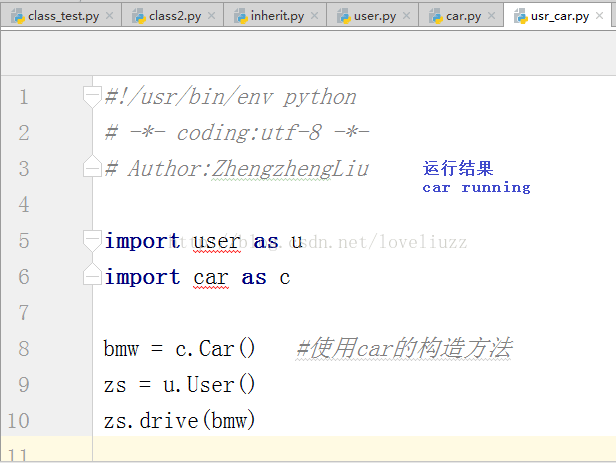
е…ідәҺвҖңPython3.5йқўеҗ‘еҜ№иұЎдёҺ继жүҝзҡ„зӨәдҫӢеҲҶжһҗвҖқиҝҷзҜҮж–Үз« е°ұеҲҶдә«еҲ°иҝҷйҮҢдәҶпјҢеёҢжңӣд»ҘдёҠеҶ…е®№еҸҜд»ҘеҜ№еӨ§е®¶жңүдёҖе®ҡзҡ„её®еҠ©пјҢдҪҝеҗ„дҪҚеҸҜд»ҘеӯҰеҲ°жӣҙеӨҡзҹҘиҜҶпјҢеҰӮжһңи§үеҫ—ж–Үз« дёҚй”ҷпјҢиҜ·жҠҠе®ғеҲҶдә«еҮәеҺ»и®©жӣҙеӨҡзҡ„дәәзңӢеҲ°гҖӮ
е…ҚиҙЈеЈ°жҳҺпјҡжң¬з«ҷеҸ‘еёғзҡ„еҶ…е®№пјҲеӣҫзүҮгҖҒи§Ҷйў‘е’Ңж–Үеӯ—пјүд»ҘеҺҹеҲӣгҖҒиҪ¬иҪҪе’ҢеҲҶдә«дёәдё»пјҢж–Үз« и§ӮзӮ№дёҚд»ЈиЎЁжң¬зҪ‘з«ҷз«ӢеңәпјҢеҰӮжһңж¶үеҸҠдҫөжқғиҜ·иҒ”зі»з«ҷй•ҝйӮ®з®ұпјҡis@yisu.comиҝӣиЎҢдёҫжҠҘпјҢ并жҸҗдҫӣзӣёе…іиҜҒжҚ®пјҢдёҖз»ҸжҹҘе®һпјҢе°Ҷз«ӢеҲ»еҲ йҷӨж¶үе«ҢдҫөжқғеҶ…е®№гҖӮ